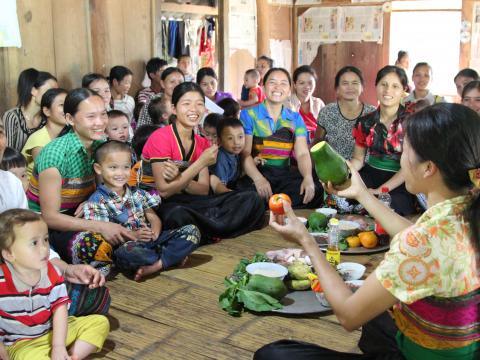Nutrition Clubs in Vietnam

World Vision Vietnam’s Nutrition Clubs provide a sustainable, community-based forum for multi-sectoral action to address childhood undernutrition. Mothers who are pregnant or have young children gather twice each month at the village level to discuss their experiences and learn better practices in child care, feeding, health, sanitation, gardening and small livestock raising. Nutrition Club meetings are facilitated by a trained community worker. Children’s growth is monitored monthly during Nutrition Club meetings. Home visits to families with malnourished children help reinforce new practices and provide early identification of severe malnutrition.
The participants also make a small monthly contribution towards a group savings account, from which the members can take loans to improve their livelihoods. These loans are typically used to strengthen smallholder farming activities through the purchase of small animals such as pigs and chickens. Thus the approach integrates improvements in food security, smallholder agriculture, economic development, health and WASH under the over-arching goal of reducing child malnutrition. The Nutrition Clubs are well received, with 70 to 80% of target participants joining in the activities. Malnutrition rates are decreasing in provinces with Nutrition Clubs, compared to those without. Results from the first two years of implementation in Tien Lu Area Programme (AP) showed a decline in stunting from 32% to 23%.
History of Nutrition Clubs in Viet Nam
World Vision Viet Nam initiated its first Nutrition Club in 2005 in Tra My district. Scale up progressed rapidly from 2009, and by the end of 2015, there were 895 Nutrition Clubs across 14 provinces, reaching almost 27,000 children.
Plans were developed to further scale up the Nutrition Club approach nationally through government health systems, including in mountainous and rural areas. World Vision handed over Nutrition Clubs implemented in Lac Son district to the local authority in 2022. As of 2023, the Nutrition Club model has implemented over 1,500 clubs across more than 40 districts, contributing to the reduction of malnutrition rate through integrated interventions at community level.
The National Institute of Nutrition (NIN) evaluated the Nutrition Club approach as a highly sustainable and effective community-based nutrition intervention. NIN has also included the Nutrition Club model into the technical guidance for implementing nutrition interventions under the National Target Programs.
The model is currently sustained under the National Target Program for Socio-Economic Development in Ethnic Minority through regular communication sessions to promote practices of nutrition, child-care, and health-seeking behaviours among parents and caregivers within the first 1,000 days of a child's life.
WV Viet Nam's nutrition clubs were featured as a case study in a Canada Food Grains publication entitled Growing Nutrition: How investing in agricultural development can improve nutrition (see page 15) and in the Viêt Nam News.
WV Viet Nam successfully advocated to the National Institute of Nutrition for government uptake of several project models, including Nutrition Clubs. As a result, the Regional SUN Civil Society Alliance has supported plans to adopt WV's Nutrition Club platform in four additional countries: Côte d'Ivoire, Kyrgyzstan, Lesotho, and Nepal.
